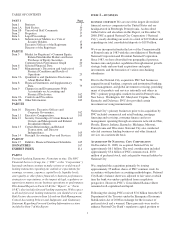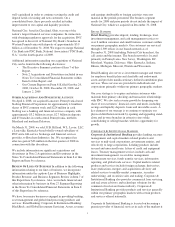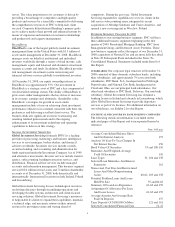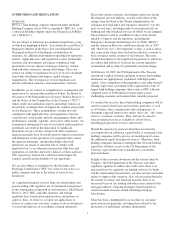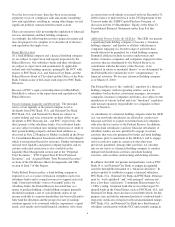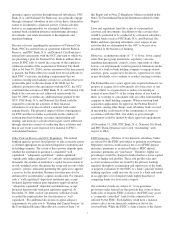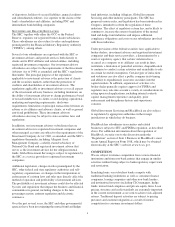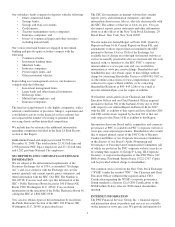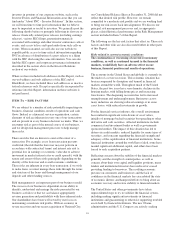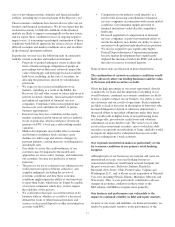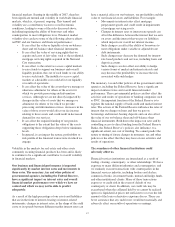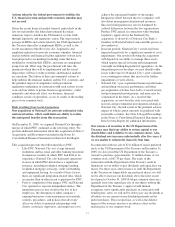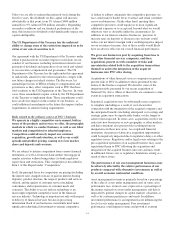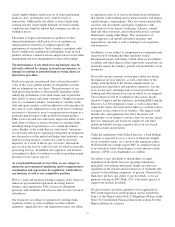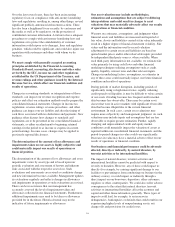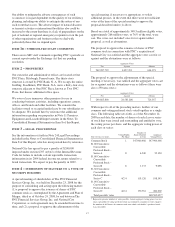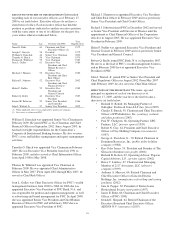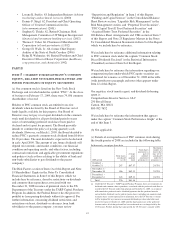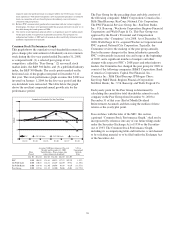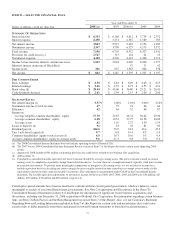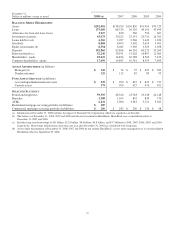PNC Bank 2008 Annual Report Download - page 16
Download and view the complete annual report
Please find page 16 of the 2008 PNC Bank annual report below. You can navigate through the pages in the report by either clicking on the pages listed below, or by using the keyword search tool below to find specific information within the annual report.financial markets. Starting in the middle of 2007, there has
been significant turmoil and volatility in worldwide financial
markets, which is, at present, ongoing. This turmoil and
volatility are a contributory factor to overall economic
conditions, leading to some of the risks discussed above,
including impairing the ability of borrowers and other
counterparties to meet obligations to us. Financial market
volatility also can have some of the following adverse effects
on PNC and our business and financial performance:
• It can affect the value or liquidity of our on-balance
sheet and off-balance sheet financial instruments.
• It can affect the value of servicing rights that we
acquire and carry at fair value, such as the residential
mortgage servicing rights acquired in the National
City transaction.
• It can affect, to the extent we access capital markets
to raise funds to support our business and overall
liquidity position, the cost of such funds or our ability
to raise such funds. The inability to access capital
markets at a desirable cost could affect our liquidity
or results of operations.
• It can affect the value of the assets that we manage or
otherwise administer for others or the assets for
which we provide processing and information
services. Although we are not directly impacted by
changes in the value of assets that we manage or
administer for others or for which we provide
processing and information services, decreases in the
value of those assets would affect our fee income
relating to those assets and could result in decreased
demand for our services.
• It can affect the required funding of our pension
obligations to the extent that the value of the assets
supporting those obligations drops below minimum
levels.
• In general, it can impact the nature, profitability or
risk profile of the financial transactions in which we
engage.
Volatility in the markets for real estate and other assets
commonly securing financial products has been and is likely
to continue to be a significant contributor to overall volatility
in financial markets.
Our business and financial performance is impacted
significantly by market interest rates and movements in
those rates. The monetary, tax and other policies of
governmental agencies, including the Federal Reserve,
have a significant impact on interest rates and overall
financial market performance over which we have no
control and which we may not be able to predict
adequately.
As a result of the high percentage of our assets and liabilities
that are in the form of interest-bearing or interest-related
instruments, changes in interest rates, in the shape of the yield
curve or in spreads between different market interest rates can
have a material effect on our business, our profitability and the
value of our financial assets and liabilities. For example:
• Movements in interest rates affect mortgage
prepayment speeds and could result in impairments
of mortgage servicing assets.
• Changes in interest rates or interest rate spreads can
affect the difference between the interest that we earn
on assets and the interest that we pay on liabilities,
which impacts our overall net interest income.
• Such changes can affect the ability of borrowers to
meet obligations under variable or adjustable rate
debt instruments.
• Such changes may decrease the demand for interest-
rate based products and services, including loans and
deposit accounts.
• Such changes can also affect our ability to hedge
various forms of market and interest rate risk and
may decrease the profitability or increase the risk
associated with such hedges.
The monetary, tax and other policies of the government and its
agencies, including the Federal Reserve, have a significant
impact on interest rates and overall financial market
performance. These governmental policies can thus affect the
activities and results of operations of banking companies such
as PNC. An important function of the Federal Reserve is to
regulate the national supply of bank credit and market interest
rates. The actions of the Federal Reserve influence the rates of
interest that we charge on loans and that we pay on
borrowings and interest-bearing deposits and can also affect
the value of our on-balance sheet and off-balance sheet
financial instruments. Both due to the impact on rates and by
controlling access to direct funding from the Federal Reserve
Banks, the Federal Reserve’s policies also influence, to a
significant extent, our cost of funding. We cannot predict the
nature or timing of future changes in monetary, tax and other
policies or the effect that they may have on our activities and
results of operations.
The soundness of other financial institutions could
adversely affect us.
Financial services institutions are interrelated as a result of
trading, clearing, counterparty, or other relationships. We have
exposure to many different industries and counterparties, and
we routinely execute transactions with counterparties in the
financial services industry, including brokers and dealers,
commercial banks, investment banks, mutual and hedge funds,
and other institutional clients. Many of these transactions
expose us to credit risk in the event of default of our
counterparty or client. In addition, our credit risk may be
exacerbated when the collateral held by us cannot be realized
upon or is liquidated at prices not sufficient to recover the full
amount of the loan or derivative exposure due us. There can
be no assurance that any such losses would not materially and
adversely affect our results of operations or earnings.
12


